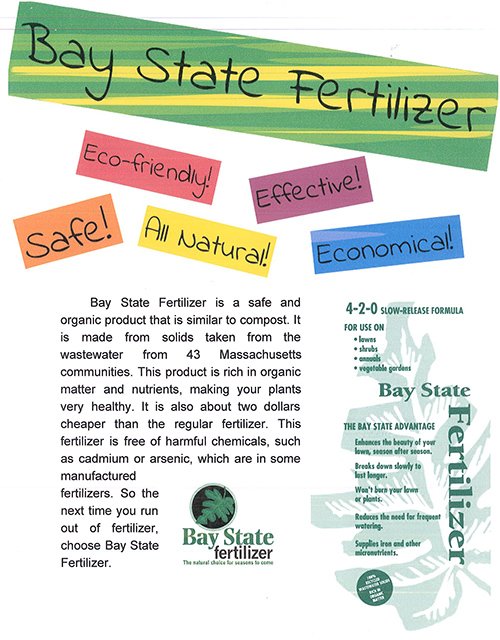I walked into science class, in a good mood after just laughing my head off with my friend. The
papers that were needed for class that day were on the front table, where my teacher always puts them. When I looked down at the day's papers, the first thing I saw was "Writing Contest" and "Bay State Fertilizer." I sat down in my seat and immediately read the paper. I have to say that I was a little let down by the prompt of the project, but little did I know that this "boring homework assignment" would turn into a fun research project that I learned lots from. After school, I went online and did some research. As I skimmed through those articles and PDF's, I started to realize that I could have already used Bay State Fertilizer every day without being aware of it! So here is what I have learned.
First, a little history. Before 1991, the wastewater coming from homes was lightly "cleaned" and then
thrown into the Boston Harbor. There, no more history. Now, the sludge goes through high temperature rotating dryers. This produces small pellets that are about 60% organic matter, which is called a biosolid. Bay State Fertilizer is a completely recycled product that comes from the wastewater of over two million people in 43 Massachusetts communities. The "sludge" from the treatment plants are turned into organic fertilizer and the treated wastewater is discharged into the deeper parts of the Massachusetts Bay. The conservative part of this product is that it is made from the solids in the wastewater that comes from our toilets, sinks, dishwashers, etc. You can imagine how much waste there is, since every person uses about 65 gallons of water every day. These solids are rich in nutrients like organic nitrogen, phosphorous, calcium, sulfur, iron, and organic matter that is good for plants and other greens. The technology used by Bay State Fertilizer ensures a slow release of nutrients, which helps conserve water and makes it last longer in greens. Bay State Fertilizer is also safe to use, having no harmful chemicals in it. Other manufactured fertilizers could have chemicals that are very dangerous like cadmium or even arsenic. Not only is Bay State Fertilizer good for your plants, it is cheap to buy. A 40-pound bag of Bay State Fertilizer costs less than five dollars, while the usual price for fertilizer is over seven dollars. This may not seem like a huge difference, but if you were to buy enough fertilizer to cover a whole golf course, you could save over 4,000 dollars! That would be enough to buy a 0.71 carat diamond ring!
So, back to the prompt. How would I inform my community leaders about Bay State Fertilizer? Well, I
have attached a small pamphlet that I made:
It shows the product, Bay State Fertilizer, and some of its uses and perks. Bay State Fertilizer is an amazing product that is like a treat for plants, with nutrients and organic matter. So the next time you dive for a ball in the outfield, or "Odell" a pass on a football field, think about how Bay State Fertilizer made the grass that you just landed on, that healthy and forgiving. Choose Bay State Fertilizer, the organic choice.
